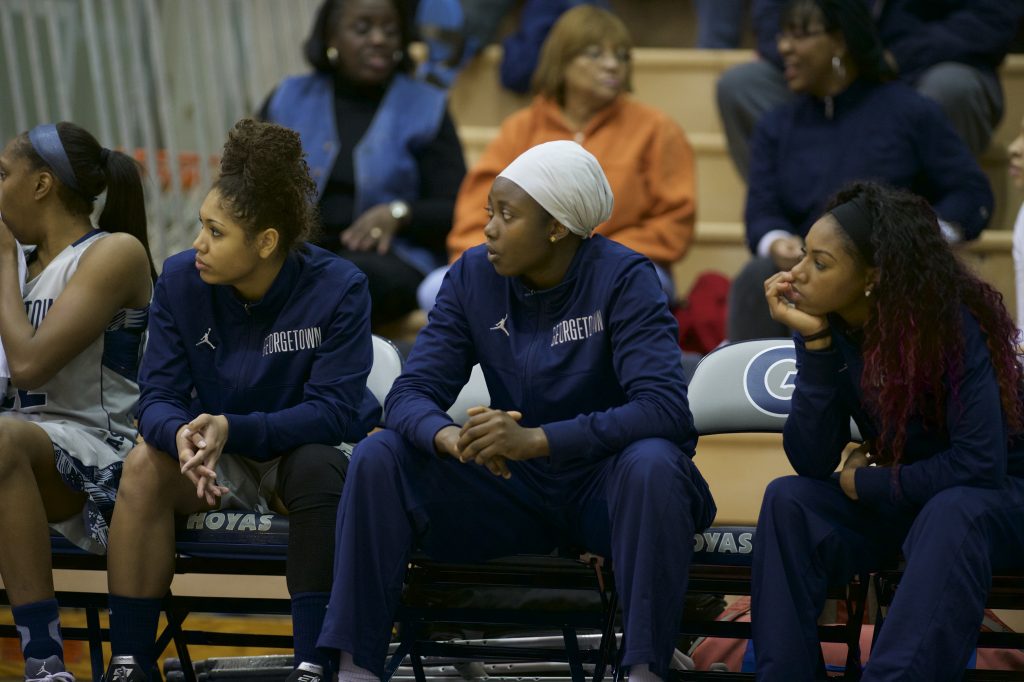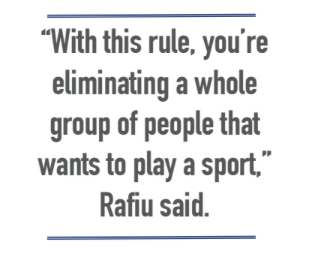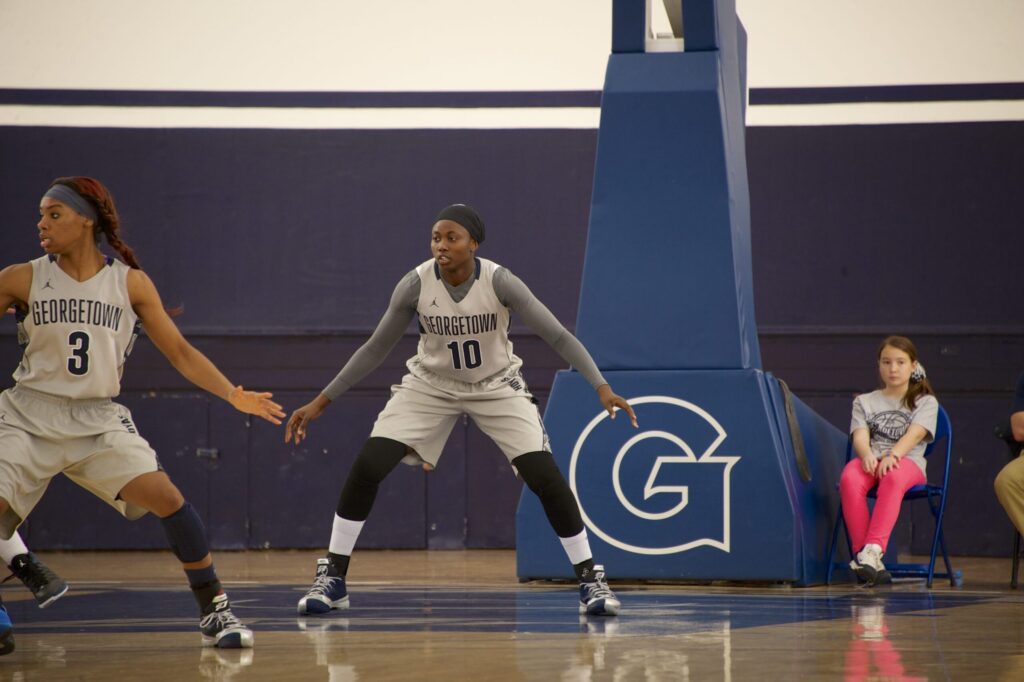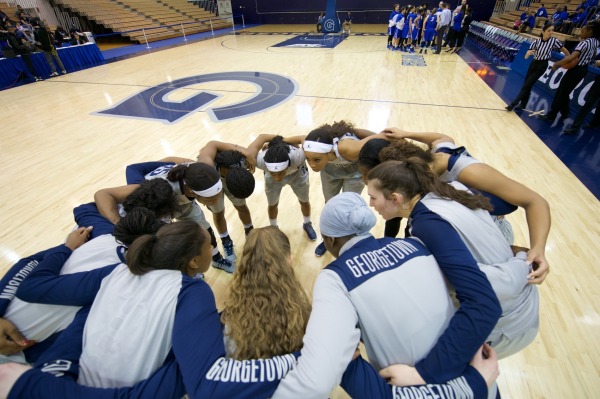For former Georgetown women’s basketball player Ki-Ke Salihu Rafiu (COL’16), a headscarf was a normal part of her uniform. Tied snugly around her head, the Georgetown-gray fabric was a way for her to live out her Muslim faith while playing the sport she loved.
Rafiu, now a graduate assistant on the team, decided to begin wearing a headscarf during games and practice during her sophomore year. She was permitted to do this thanks to the NCAA’s non-restrictive policies regarding religious headgear.
But such accommodation isn’t the norm at every level of basketball. The International Basketball Federation (FIBA), the worldwide governing body of professional basketball, currently restricts players from wearing any religious headgear on the court.
While FIBA has long cited safety concerns as justification for this ban, the policy has met with clear opposition from athletes who wish to cover their heads, who claim it forces players to choose between their sport and their faith.
“You can tell that I’m a Muslim, and it shouldn’t be a problem when I say I want to cover my hair,” Rafiu said. “But, apparently, in today’s world, it is a huge problem.”
Article 4.4.2
At the college level, the process for requesting permission to wear religious headgear is straightforward – players submit basic paperwork and an explanation to the NCAA. The coach is then given a letter from the NCAA as a response to potential inquiries from referees.
“You sign a waiver, and everything is done,” Rafiu explained. “It’s a really easy process.”
Although athletes who wear faith-based headgear are met with accommodation at the college level, they face a greater challenge when it comes to playing in professional leagues.
Article 4.4.2 of FIBA’s Official Basketball Rules bars players from wearing “equipment that may cause injury to other players,” including “headgear, hair accessories and jewellery.” Players are permitted to wear headbands provided that they’re less than five centimeters in width.

Ki-Ke Rafiu watches from the bench during a game.
Because FIBA is the chief organizer of professional basketball at the national and international levels, any player who chooses to cover their head for religious reasons — whether with a hijab, turban, or yarmulke – is severely restricted from playing professionally or internationally. A basketball player who wears a headscarf, for example, currently cannot represent their country at the Olympics.
“So [for] anything that’s international, that rule literally stops you from doing what you wanna do,” Rafiu said.
The impact of this ban was seen front and center at the 2014 Asian Games, when Qatar’s women’s basketball team walked off the court after being told they could not wear their hijabs during their game against Mongolia, forfeiting the game.
But the effects are even more far-reaching, posing barriers for many aspiring players hoping to go pro. Bilqis Abdul-Qaadir, for instance, graduated high school as the leading scorer in Massachusetts state history, and went on to play Division I at Memphis University and Indiana State University. Despite her athletic talent, her dreams of playing in a professional league overseas were shattered when she learned about the restriction.
“With this rule, you’re eliminating a whole group of people that wants to play a sport,” Rafiu said. “Because of just one rule, you say no, they cannot do it. Isn’t that discriminatory?”
Safety Concerns
While FIBA has consistently maintained that Article 4.4.2 is in place purely out of concern for player safety, athletes like Raifu remain skeptical, pointing out that there is no evidence that headgear actually poses a danger. Soccer’s governing body, FIFA, had a similar headgear restriction in place until 2014. After a successful two-year trial period they found no safety concerns associated with players wearing religious headgear.
“I played with a headscarf on my head at Georgetown,” Rafiu said. “I never hurt anybody, and I never got hurt.”
Georgetown theology professor Ori Soltes recently published God and the Goalposts, which looks at the historic intersections between religion and sports. He also expressed his skepticism regarding these safety concerns. As an example, he referenced the story of a local high school basketball player in Maryland who, after participating all season with no problems, wasn’t allowed to play in her team’s final game because of her hijab.
“Is that because [her hijab] was dangerous in that game, but not in the previous 24 games? That sounds a little bit suspicious to me,” Soltes said.
Similarly to the NCAA, the National Federation of State High School Associations rule book technically requires a signed waiver in order to allow wear religious headgear – but neither the player, Je’Nan Hayes, nor her coach were previously aware of this. That’s because the rule had rarely been enforced, leading some to question the referee’s decision to strictly follow it in this specific instance.
“I would be inclined to suppose that when the authority – whether it’s an individual referee, or whether it’s FIBA, or whoever is it – says that a player cannot wear headgear that is part of that player’s religious obligation, then that is a combination, let’s say, of ignorance, and being opposed to that person’s religion,” Soltes said.
Stoles is willing to grant that the decision might come more out of ignorance than prejudice, but he still finds the potential danger of headgear to be a weak explanation for keeping players – whether in high school or at the professional level – from playing the game. “I don’t think it’s genuinely about safety,” he said.
“I don’t think it’s genuinely about safety,” he said.
In a broader context, Muslim women facing adversity as a result of wearing a headscarf or hijab is not uncommon. Kristin Sekerci, research fellow at the Bridge Initiative, Georgetown University’s Islamophobia research project, noted that the hijab has become largely politicized within national discourse, and is often viewed as threatening.
“You have to wonder if that kind of rhetoric is saturating into even these apolitical fields, like sports,” Sekerci said.
Fighting Back
In 2014, Bosnian-American professional basketball player Indira Kaljo created a petition on Change.org urging FIBA to follow in FIFA’s footsteps. With nearly 70,000 supporters, this petition was initially successful – FIBA introduced a two-year trial period during which players would be allowed to wear religious headgear on a limited basis. The final decision on the matter was supposed to be made in August 2016, but this date was later postponed. In March, FIBA announced that a proposed rule change would be presented to the Mid-Term Congress in May.
Rafiu, Abdul-Qaadir, and other basketball players joined Kaljo in starting a second petition in 2016 pushing for a final decision. Rafiu felt compelled to join the movement due to its personal relevance to her, not only as a Muslim athlete, but as a Hoya.
“Georgetown also played a role [by] helping me to practice my faith while I play the sport that I like during my undergrad,” she added.
While the petition was met with overwhelming support – gathering over 130,000 supporters – not all responses were positive.
“When we submitted our petition online, there were a lot of terrible comments from people,” Rafiu said. “But that never made us back down from what we’re standing for, and what we’re fighting for.”

Rafiu on the court.
Increased Visibility
Despite current challenges within the world of basketball, Muslim women have nonetheless seen a huge boost in visibility elsewhere in the athletic world. At the 2016 Summer Olympics, American fencer Ibtihaj Muhammad made history as the first member of Team USA to wear a hijab, winning a bronze medal while representing her faith. And thanks to a last-minute rule change by the International Volleyball Federation, the Egyptian women’s beach volleyball team was able to compete in the games for the first time, wearing clothing with more head-to-toe coverage than is traditionally required for the sport.
“At its best, sports is about [how] you succeed by the sweat of your brow, and not by the color of your skin, or the form of your faith, or your ethnicity,” Soltes said. “At its best that’s what it’s all about, that’s what the Olympics is supposed to be all about.”
Some athletic brands are also contributing to this increase in visibility. Nike recently announced the release of their new “Pro Hijab,” a line of athletic-style headgear aimed at Muslim women athletes.
Sekerci explained that increased visibility could have a positive impact by helping people to look beyond negative stereotypes and perceptions of Muslims.
“I think the more we humanize these experiences, the more it’ll kind of demystify the hijab as this scary ‘other’ thing, and just a normal part of the way people dress in the morning and live out their faith,” Sekerci said.
Nike has been celebrated for their nod to inclusivity. However, Sekerci believes that Nike should also do more to use their influence where it counts, such as by joining the push to convince FIBA to overturn the policy that prevents many Muslim basketball players from actually playing.
“While I think it’s really cool that [Nike] is considering to design a clothing line for athletes who wear hijab, it would also be really appreciated if they could throw their corporate muscle around and talk to these international federations,” Sekerci said. “If they really care about athletes, which I know they say they do, that’s something I think many would appreciate and would really like to see them step in and do.”
In the meantime, former and current Muslim women’s basketball players like Rafiu remain at the front lines of the FIBA battle, and continue to argue that lifting the headgear ban would give more athletes the opportunity to participate in the sport without compromising their religious beliefs.
“If FIBA can lift the ban, the game is gonna grow tremendously in a lot of areas,” Rafiu said. “And I think this is what FIBA actually wants.”
Looking beyond the impact on the athletes themselves, Sekerci thinks that lifting the ban could send an even greater message.
“It’s more like this greater narrative of whether we’re willing to make room for other forms of representation, other forms of identity, other forms of just how you wear your uniform.”





